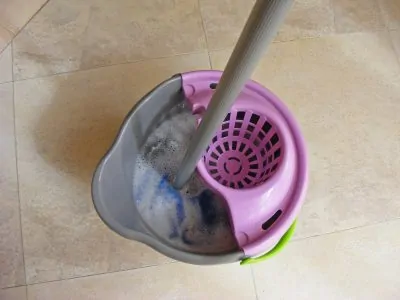Have you just bought a steam mop and feel a little lost on how to use it? Do you want to know how you can get the best from your new investment? Don’t worry; we’ve been there: it can seem like a foreign object at first.
You may have purchased a steam mop because it’s a convenient, germ-killing tool – just what you need for a busy family home. We have been using a steam mop for years and absolutely love it.
If you don’t know how to use it properly, we’ll answer some common questions and provide a step-by-step guide for getting started. Soon, you’ll realize how much of a breeze a steam mop is to use!
Key Takeaways
- Steam mops use high-temperature water vapor to clean floors and kill bacteria.
- They work on sealed surfaces like tiles, grouting, linoleum, and ceramic, but not on unsealed hardwood.
- Before using a steam mop, vacuum or sweep the floor to remove loose dirt and debris.
- Use distilled or demineralized water in a steam mop to prevent mineral buildup and damage.
How Does a Steam Mop Work?
When connected to a power outlet, the water heats up to around 245 degrees Fahrenheit. Some may be lower in temperature, while others could go higher. The hot water vapor is then emitted from the base onto the mop pad.
The steam loosens tough dirt and grime, which the mop pad absorbs. It can even remove stains and mold.
What Floors Can I Clean With a Steam Mop?
You can scrub various surfaces, including tiles, grouting, linoleum, ceramic, and carpet. The key is that the flooring must be sealed to avoid excess moisture damaging vulnerable materials.
In particular, it’s recommended to avoid unsealed hardwood. The steam can warp the wood and lead to swelling and discoloration.
If you don’t know whether your flooring is sealed, you can do a water test. Choose a contained area and drop small amounts of water onto it. If the water isn’t absorbed after a few minutes, this may mean that it’s sealed and safe for steam mops.
Can I Use a Steam Mop on Carpet?
It may be possible to use some multi-function steam mops on the carpet. This is usually down to the inclusion of an accessory called a carpet glider. A carpet glider clips onto the mop head to prevent resistance from the carpet.
However, we recommend referring to the user manual before using your steam mop on carpet. The last thing you want is to distort the color or appearance. Steam may damage carpets with artificial fibers, and Berber carpets might become fuzzy.
How Often Should I Use a Steam Mop?
It depends on how dirty your flooring can get. On average, most families use a steam mop around once a week. It may be more if you’re busy and active.
In our home, the steam mop comes out a little more often than weekly. This is down to having a very muddy dog!
Can I Fill the Water Tank With Cleaning Solution?
Steam mops only require water to function. Topping them up with your own cleaning solution may damage it, as well as your flooring.
Some steam mops have additional accessories, such as scented demineralized steam mop water. But it’s best to read your user manual first to make sure it’s compatible with your model.
Plus, you can take advantage of not using any toxic or harsh chemicals in your home. This may help those with allergies, as well as be safe for children and furry friends.
If you want to add a pleasant scent, check with your manufacturer, as they may allow a few drops of essential oil to be added to the water tank.
Can I Use Tap Water for a Steam Mop?
If you live in a region with hard water, we don’t recommend tap water. This is because it can contain minerals, such as calcium and magnesium (1).
While tap water may be safe to drink, it might damage your steam mop. There’s a possibility that minerals may block the steam outlets over time. We’d suggest using distilled or demineralized water to prevent this from happening.
Will Using a Steam Mop Kill Germs?
Yes. Fortunately, steam mops can kill bacteria and pathogens due to the high-temperature water vapor.
For example, studies have found that steam can significantly reduce Acinetobacter baumannii, VRE, and MRSA (2). You can also use it to sanitize and remove Clostridium difficile too (3). Another big one that can be attacked with steam is Salmonella, an important factor for those that do a lot of cooking.
Idle The Steam Mop For Five Seconds To Kill Bacteria
How to Use a Steam Mop
The size and style are going to be up to you. But the good news is that all steam mops operate similarly. This means the primary steps will be, more or less, the same.
- Time: 15 minutes
- Difficulty: Easy
1. Remove Any Obstacles and Loose Objects
Remove anything that could become an obstacle to getting the mopping done quickly.
Steam mops usually have rotating mop heads for working around any furniture. But it may be easier to see what areas need cleaning when you move them from the get-go.
2. Sweep or Vacuum First
First of all, it’s best to sweep or vacuum your floor before bringing out the steam mop. You may think this is counter-productive – aren’t you using more time using two cleaning tools? Well, it’s going to be faster and be more effective for cleaning.
It’s better to use the suction power provided by a vacuum for loose dirt and crumbs. The mop pads will get less dirty, and the steam mop can concentrate on stains and grime. Dragging large pieces of debris around the house on the mop may also cause unnecessary scratches on your floor.
It doesn’t have to be an intense vacuuming session – just get rid of grit you see lying around. You may be interested in an all-in-one steam mop, offering a vacuum combined with a steam mop. It can be handy if you’ve got limited storage or just want to avoid the hassle of several cleaning accessories.
3. Prep Your Steam Mop
If your steam mop is cordless, make sure it’s charged and ready to go.
Next, attach the mop pads to the base with Velcro or towel clips, depending on your model. Many steam mops come with mop pads included, either reusable or disposable. Still, you may want to purchase extras just in case.
While you’re mopping, it’s beneficial to have several mop pads in your cleaning holster so you can change them if they get too dirty. The last thing you want is to smear grime back onto your clean surfaces.
Now, fill the water tank up to the maximum capacity line.
Connect your steam mop to the nearest power outlet or simply turn it on if it’s cordless. Let it warm up for around 20 to 30 seconds. There may be an indicator light to show you when it’s ready to use.
4. Start Away From the Doorway
Nobody wants to walk over the floor they’ve just spent time cleaning. To avoid this, start at the corner furthest from the doorway.
It’s easiest to clean in straight lines to monitor where you’ve already been. Glide the steam mop gently in a back-and-forth motion for the best results.
5. Don’t Leave the Steam Mop on and Unattended
It doesn’t matter whether the delivery man is at the door or the phone rings, avoid leaving your steam mop. If it’s concentrated on one spot of the floor for too long, it may damage it.
If you have to stop mid-session, just remember to turn it off.













